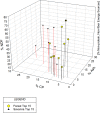The nutritional content of Tana River yellow baboon (Papio cynocephalus) foods in a partially forested habitat
- PMID: 30439991
- PMCID: PMC6237341
- DOI: 10.1371/journal.pone.0207186
The nutritional content of Tana River yellow baboon (Papio cynocephalus) foods in a partially forested habitat
Abstract
Here we report the first dietary macronutrient and mineral content information for a little-studied yellow baboon group (i.e., the Mchelelo troop) at the Tana River Primate National Reserve, Kenya. We compare forest to savanna samples for this troop found in a partially forested habitat. Observations conducted between 1988 and 1992 determined our list of foods. Subsequently, flora samples, representing 56 species, were collected between April 2008 and March 2009 with nutrient content determined via standard procedures for fiber, gross energy, ash/minerals, crude protein, and crude fat/lipids. Concentrations of specific minerals (calcium, iron, magnesium, manganese, phosphorus, potassium, zinc) were also measured. We predicted forest items would be higher in gross energy and lipids and savanna items higher in crude protein, fiber, and minerals. Our analyses support only the predicted difference in crude protein for savanna items for the overall dataset. In our examination of the top 15 foods, savanna items had significantly higher crude protein, ash, magnesium, and manganese while forest items had higher gross energy. Right-angled mixture triangles show some clustering by location but with substantial overlap in values. Our data provide further indication of the particularity and purposefulness of dietary choices made by primates. They also contribute to the broader discussions of primate nutritional ecology and are a first step towards an examination of macronutrient balancing for this group. Finally, we discuss the impact heavy reliance upon forest products by a "savanna species" may have upon competitors and forest composition. Ultimately, we show that there is still much to be learned about baboon nutrition.
Conflict of interest statement
The authors have declared that no competing interests exist.
Figures
References
-
- National Research Council. Nutrient requirements of nonhuman primates, 2nd revised edition Washington, DC: National Academies Press; 2003.
-
- Altmann S. Foraging for survival: Yearling baboons in Africa Chicago: University of Chicago Press; 1998.
-
- Chapman C, Chapman L, Rode K, Hauck E, McDowell L. Variation in the nutritional value of primate foods: among trees, time periods, and areas. Int J Primatol. 2003;24: 317–333.
-
- Milton K. Nutritional characteristics of wild primate foods: do the diets of our closest living relatives have lessons for us? Nutrition. 1999;15: 488–498. - PubMed
-
- Norconk M, Conklin-Brittain N. Variation on frugivory: the diet of Venezuela white-faced sakis. Int J Primatol. 2004;25: 1–26.
Publication types
MeSH terms
Substances
LinkOut - more resources
Full Text Sources
Medical
Research Materials
Miscellaneous



